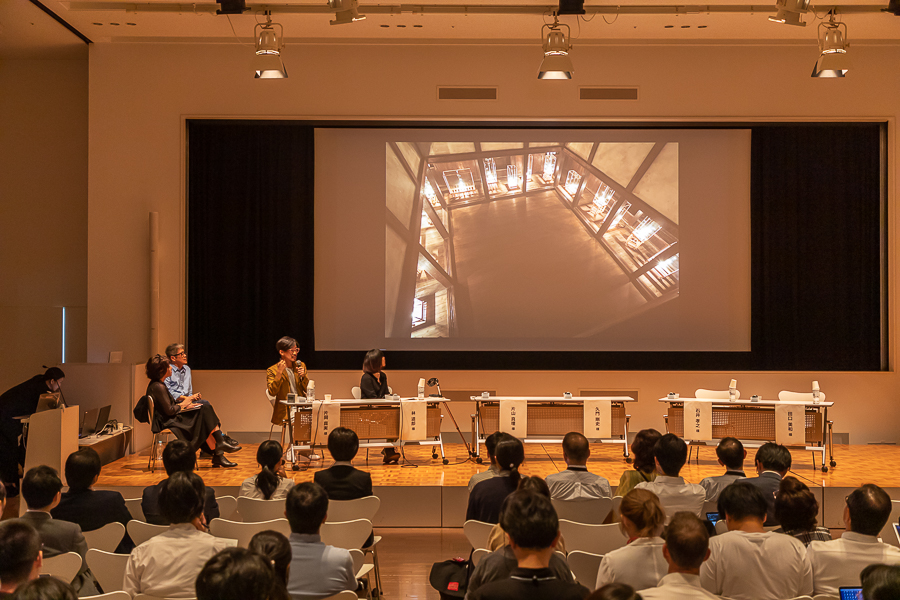Writer/editor born in Kagawa, and currently based in Tokyo, Kagawa and Kyoto. Majored in Art Studies at Meiji Gakuin University, Graduate School of Arts and Letters. Has been active as an editor, writer, checker and transcriber mainly for art-related books and magazines, as well as for online publications, catalogues, etc. Is presently in charge of coordination, composition, research and writing for the serial columns “Masamichi Toyama + Yoshio Suzuki ‘Kyo mo art no hanashi o shiyou (Let’s talk about art again today)’” and “Ayaka Wada’s ‘Art ni muchu! (Absorbed in art!)’” in the application version of Pia.
photo by Ujin Matsuo
The Agency for Cultural Affairs’ “Art Platform Japan” is a program in which opinions are collected from individuals involved with contemporary art, with the aim to promote activities to raise the international evaluation of artists from and/or working in Japan, and thereby achieve sustained development of contemporary art in Japan. Artists, curators, critics, collectors, gallerists and other participants from the contemporary art world gathered to discuss the supposed role of this program that has been attracting attention also from the viewpoint of the Japanese government’s growth strategy.
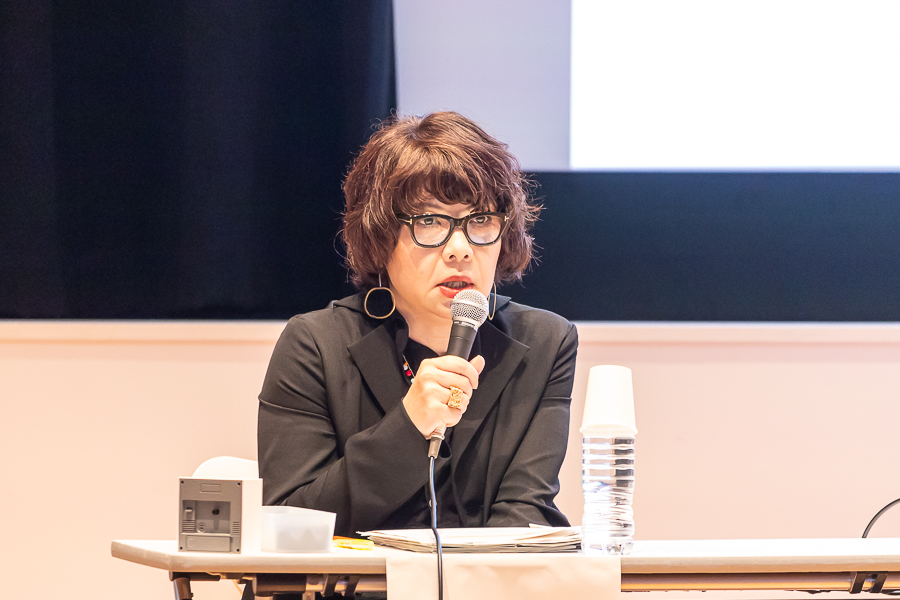
Mami Kataoka photo by Ujin Matsuo
What should people involved in contemporary art in Japan do?
Mami Kataoka (former deputy director, and current director of Mori Art Museum) first outlined the problems and issues regarding contemporary art that Japan is facing today and introduced concrete measures that are being taken to tackle these.
“Up to 2014, the government (the Agency for Cultural Affairs) did not have any strategic discussions with regard to contemporary art, but now we have a clear agenda of issues to be tackled for the promotion of Japanese contemporary art on the global stage. While Japanese contemporary art used to be highly evaluated, and especially artworks from postwar Japan attracted attention around the world, one major problem for us is the fact that we don’t have easy access to such works and related materials today.” (Kataoka)
In 2017, the Cabinet Secretariat installed the Special Unit for Strategic Planning on Culture & Economy and formulated cultural and economic strategies. In 2018, the framework included for the first time a budget for programs aimed to revitalize the art market, resulting in the launch of the Agency for Cultural Affairs’ “Art Platform Japan.” The Japan Contemporary Art Committee that Kataoka is heading functions as a steering committee for this program. At present, the Committee’s work is mainly dedicated to the development and implementation of four concrete measures: 1) the construction of a network of curators, researchers and other individuals in Japan and abroad; 2) expansion on a global scale through the translation of texts that are essential for raising the international evaluation of art made in Japan; 3) the creation of websites for the dissemination of multilingual information; and 4) the visualization of information on artworks collected in Japan.
Kataoka referred to the situation of a diminishing presence of Japanese artists in relation to the international art fairs and exhibitions that are being held in addition to regular museum activities in countries around the globe, and of a significant decrease of invitations of Japanese artists to international shows. Given that the focus is no longer only on Western art, but also on artists from non-Western countries, she further suggested that museums and curators in Japan make greater efforts to build human networks, while referring to specific workshops that are being organized in this respect.
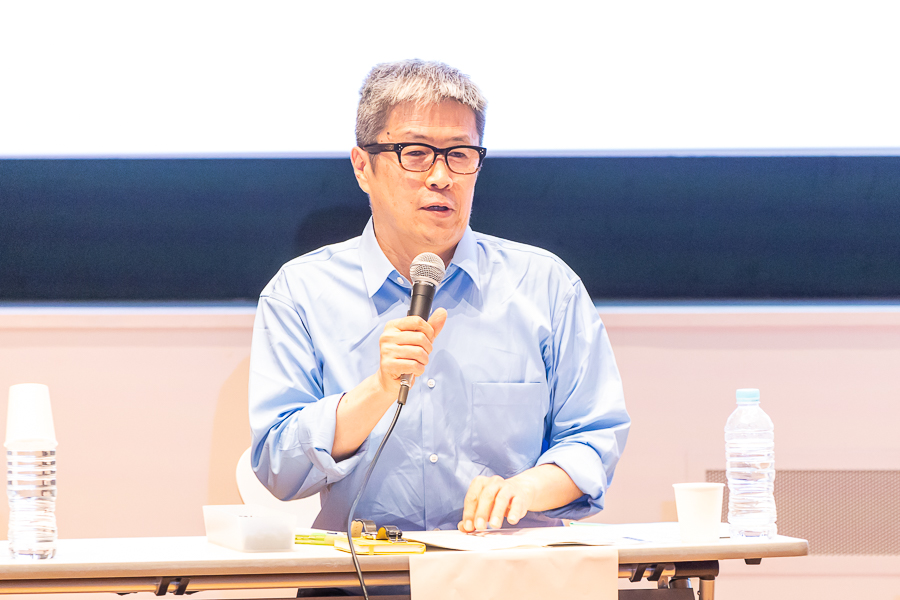
Michio Hayashi photo by Ujin Matsuo
Michio Hayashi, an art critic, professor at Sophia University’s Faculty of Liberal Arts, and the Committee’s (then) vice chairman, also referred to the necessity of translation and website building.
“Now that the focus on American and European culture has largely disappeared, museums are all eager to dismantle their images of modern history and rewrite their own stories of modern art. Against this backdrop, Japanese modern and contemporary art does attract attention, but the situation today is that such works are not being placed and understood in their proper contexts. The number of books and essays that have been translated into foreign languages is overwhelmingly small,” he pointed out, adding that the committee is in the process of selecting and translating books, important critical essays, and other texts that should be translated.
He also mentioned the need for websites and databases that provide multilingual information on items in the respective collections of art museums in Japan, for which “English is certainly still the lingua franca. As a country that is significantly behind in terms of English correspondence, Japan should work to be able to respond as needed, and provide the required information,” he summarized the committee’s activities.
What is happening on the global front?
Guest presentation by artists invited to the Venice Biennale 2019
Following were presentations by Mari Katayama and Tsuyoshi Hisakado, two artists featured in the “May You Live in Interesting Times” exhibition at last year’s Venice Biennale (May 11 – November 24, 2019).
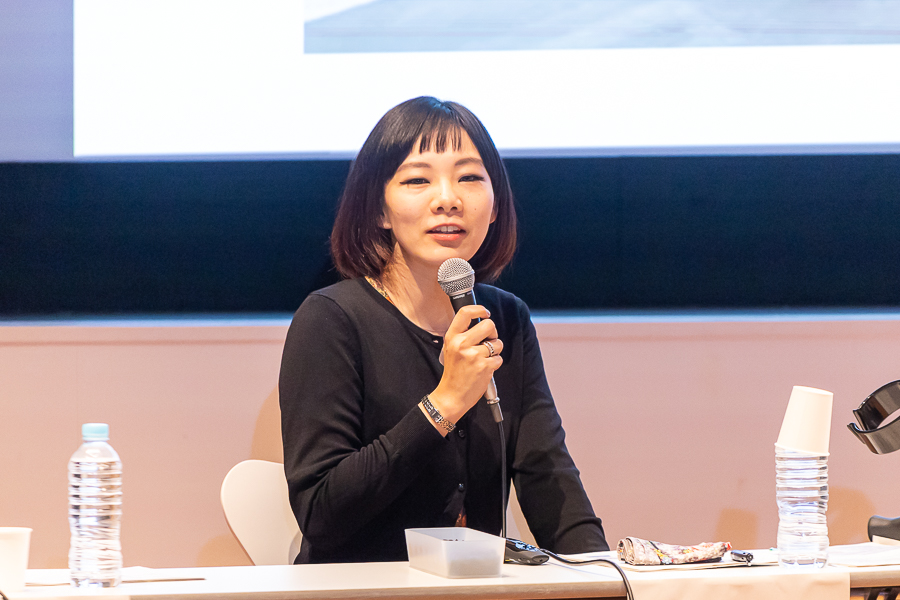
Mari Katayama photo by Ujin Matsuo
Mari Katayama
Mari Katayama is an artist who creates self-portraits using various hand-sewn, body-shaped items, ornamented prosthetic legs, and other objects. In addition to her creative work, she has also garnered attention with her “High Heel Project” encompassing a wide range of activities such as singing, modeling and lecturing while wearing high-heeled shoes she has custom-made for her prosthetic legs.
In August 2018, Venice Biennale director Ralph Rugoff got in touch with Katayama and suggested exhibiting her works, and her participation was decided in October. About the notice of her participation, the artist remembered that “it was a truly moving and rich experience.”
Katayama’s works were eventually exhibited in the Giardini and Arsenale venues, at both of which she repeatedly experienced situations of bewilderment and surprise. For the display at the Arsenale, she had commissioned an Italian carpenter to make a table to place her work on, but when she received the table, it wasn’t even. “When I pointed out the flaw, the carpenter climbed onto the pedestal (which was part of the work) to demonstrate that it was just fine. It was quite nerve-wracking but it was also a funny experience.”
At the Giardini, she exhibited photographic works and was taken aback when witnessing how the cleaning staff team diligently wiped the acrylic parts with a wet cloth. “That moment, I remembered how someone back in Japan had told me that a lot of artists don’t exhibit their most important works despite the ‘Olympic’ kind of character of such international art events. I couldn’t really believe that at first, but when I saw what they did with my works, I understood that it made perfect sense because you never know what will happen. It is quite natural that it takes a fair amount of time for information to get through to all corners of the system at large international art fairs. Also in this sense, I realized how important it was to share information. In Venice, I just plunged into it without knowing much about the spatial and climatic conditions in which my works were to be exhibited. But it is, of course, a high-status event, and being part of it was a great honor for me, and also a chance to learn a thing or two,” she looked back on her time in Venice.
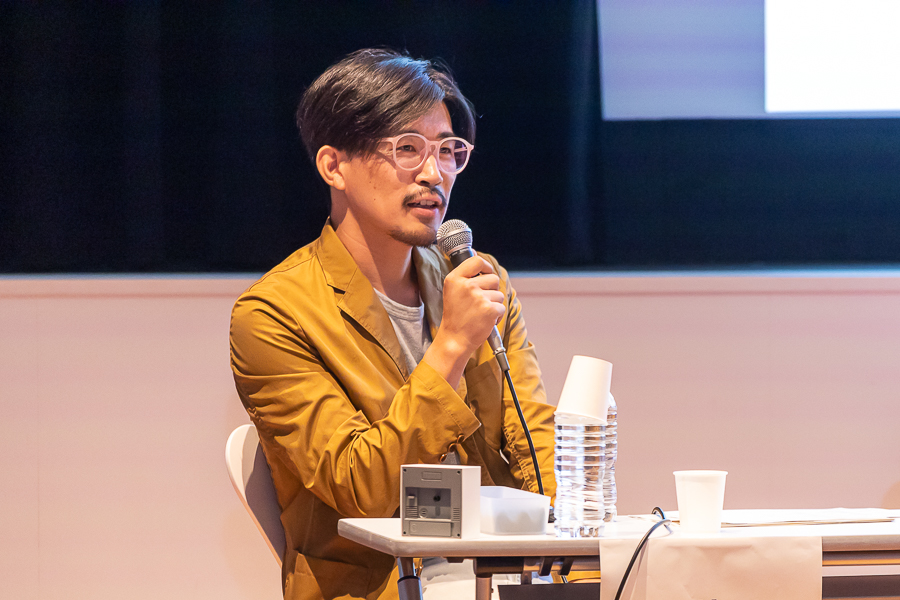
Tsuyoshi Hisakado photo by Ujin Matsuo
Tsuyoshi Hisakado
“They approached me in a sharpshooting manner with the offer to exhibit ‘Synchronicity,’ a work made in collaboration with Apichatpong Weerasethakul,” explained Tsuyoshi Hisakado, an artist who has been sampling all kinds of phenomena and historical facts to orchestrate theatrical situations incorporating elements of sound, light and three-dimensional objects, for viewers to reencounter individual memories and stories.
Related to “Memoria,” a video that Apichatpong Weerasethakul made in Colombia, the work is themed on contrasts between the personal memories of individuals and the collective memories of communities and nations, while also referencing depth psychology and cranial neurology. Hisakado was involved as a collaborator and contributor from the initial conceptual stage.
Weerasethakul contacted Hisakado on January 1st, 2019, at a time when he was in the middle of shooting “Memoria.” As it was difficult for him to participate both in a physical and mental sense, he suggested that he wouldn’t be able to help with the installation, but if Hisakado was interested he would leave it to him to go ahead and take control of the exhibition by himself.
However, things didn’t work out without a whole set of complications, especially financial ones: “It was only after completing all the paperwork that I understood that expenses wouldn’t be covered sufficiently. As there are extremely few Japanese artists that had participated in any of the previous exhibitions, there wasn’t much information available, so I had no way of knowing. I had a really hard time without anyone I could ask for advice,” he recalled the situation.
Once in Venice, Hisakado solved some of the arising problems, while others remained. “Next to creating works at my own atelier and then taking them to exhibitions, I generally visit the location of the exhibition first, see what kind of place it is, and what kind of work seems fitting for an exhibition there. It frequently happens that I create something at the venue, so in this case, there was quite a lot for me to do in Venice, which is why I asked the staff to finish the construction work by the time of my arrival. As it turned out, they didn’t keep their promise, so eventually, almost six days passed before I could finally start working. The Italian people like to say ‘Domani, domani,’ but it rarely happened that they really got something done the next day…(laughs)” While looking back on the rather troublesome work with the Italian team who “preferred doing things their own way rather than as [he] told them to,” Hisakado appreciated that “they invited [him] after having processed and understood the works, and taken their time to make preparations,” while also being thankful for the new connections he took home.
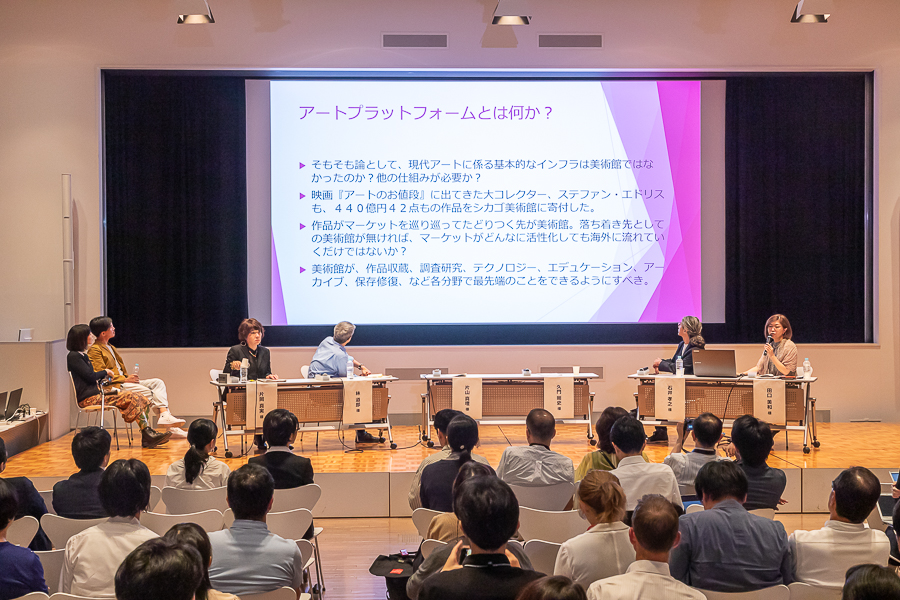
photo by Ujin Matsuo
Panel discussion
Takayuki Ishii / Owner of Taka Ishii Gallery, representative director of the Fine-Art Photography Association
Miwa Taguchi / Taguchi Art Collection
Mari Katayama / Artist
Tsuyoshi Hisakado / Artist
Moderators: Mami Kataoka, Michio Hayashi
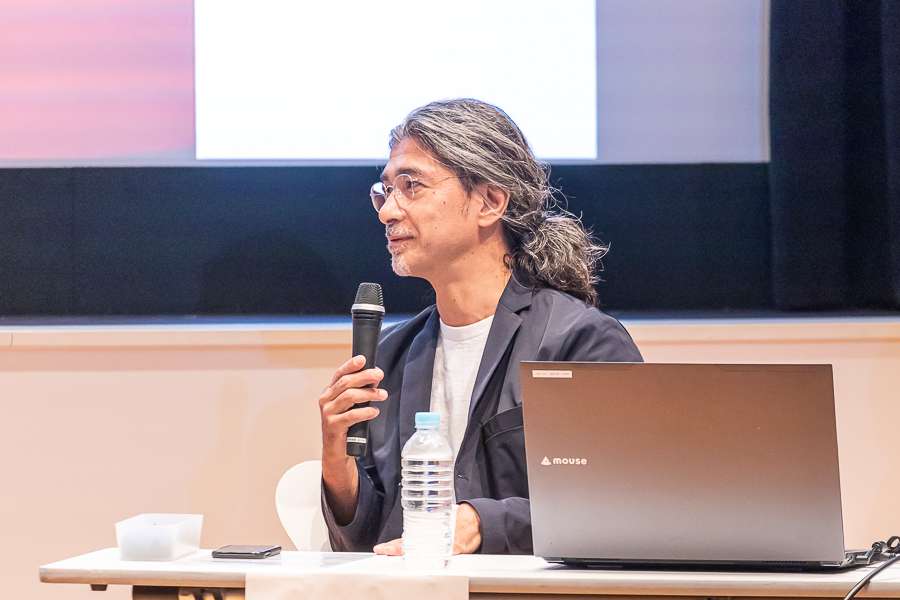
Takayuki Ishii photo by Ujin Matsuo
How is Japanese art being presented on the international stage?
The last point on the program was a panel discussion that started with a presentation by Takayuki Ishii, gallerist and owner of one of the leading contemporary art galleries in Japan.
In his gallery, Ishii has been exhibiting works ranging from Japanese postwar to contemporary art, with a special focus on artists that are less widely known outside Japan. At this occasion he stressed that he keenly realized how far they were lagging behind in terms of international reputation.
“When I showed Jikken Kobo[1] at the Frieze Art Fair in London in 2007, I was astonished to see that not only collectors but also museum curators didn’t know anything about them. I feel that, even when there is a great demand at galleries or auctions, artists will not be selected to participate in international art shows and museum exhibitions as long as curators show no interest, so not being known really is a waste. It was in fact through my introduction of the Jikken Kobo members that some of them made their way into Tate Modern, and eventually drew the interest of all sorts of people.
“I also believe that there should be more experimental and sensational exhibitions in Japan that attract the attention of the international art audience, realized with support from companies or individuals, and utilizing state-run facilities. If the state takes the initiative, it is surely possible to generate a lot of energy.”
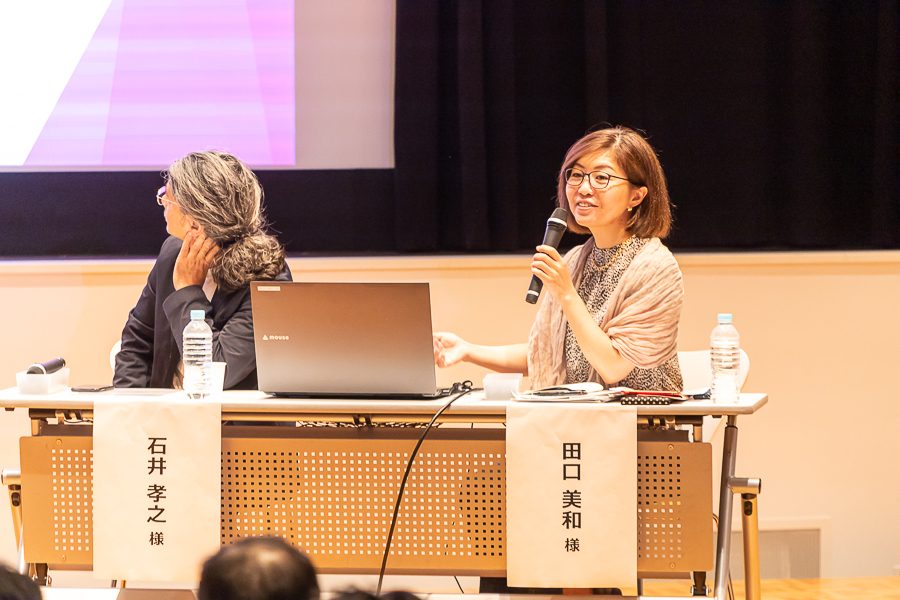
Miwa Taguchi photo by Ujin Matsuo
The presence of Japan in other parts of the world
Next was Miwa Taguchi, an international contemporary art collector who has been visiting art fairs and exhibitions in all parts of the world. Her report revolved around the question of how the presence of Japan is perceived globally from a collector’s point of view.
With the introductory remark that this only represents one collector’s impression, she claimed that “the presence of Japan is very thin.” She further elaborated that, at receptions of events like the Venice Biennale, for example, there were usually opening speeches by people such as French ministers and the director of the Centre Pompidou, who had been invited from France. Such parties are occasions of a highly social nature and important opportunities for exchanging information and making new acquaintances.
“When people from museums in Western countries go to art fairs, they often take along collectors, as such fairs are opportunities for them to share information, introduce and promote artists and works they are interested to the collectors. One can clearly see the approach to building a collection as a cooperative effort. For museums in the West, it seems to be a natural perception to see their mission in the collection of artworks in order to build history and historical connections by way of art and culture,” she explained, adding that people in Japan had a lot to learn from the West in this respect, as this kind of approach is still more or less non-existent in the country.
Taguchi finally suggested a set of issues that Japan should focus on in the future, with a special emphasis on “the importance of the human factor, as art is made, evaluated and connected by humans.” “No matter how solid the system is, without human individuals, there is no presence, and this is what makes the creation of strong ‘individuals’ and networks to connect them such an essential task,” she concluded her presentation.
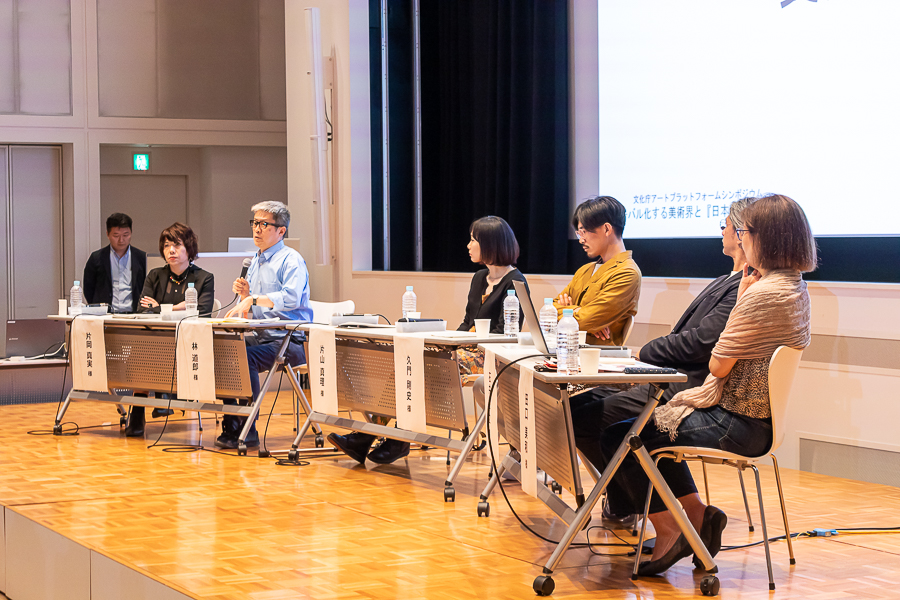
photo by Ujin Matsuo
Issues to be tackled in the future
Responding to the presentations by Ishii and Taguchi, Michio Hayashi summed up the issues to be tackled in the future as follows. “Holding exhibitions and other events aimed at creating connections between human individuals is something that also art museums and galleries will have to think about, and for museums dedicated to contemporary art in particular, it will be important to build appropriate relationships with their respective patrons.”
The event closed with Mami Kataoka’s remark: “Against the backdrop of Japan’s diluted presence in the international arena, it will be necessary to keep negotiating in order to define and promote our own position. We also need to specify how curators, artists and researchers in Japan and other regions are supposed to discuss such common issues as decolonization, diversity and environment that the world is facing today.”
This symposium highlighted the shortcomings in terms of information sharing and network building in Japan, as well as such issues as the financial support of artists. It was indeed a precious opportunity also in terms of defining problems regarding the promotion of contemporary art that have to be tackled, and learning about the concrete measures the Agency for Cultural Affairs has been implementing in their programs and network-building efforts. We are going to observe closely how the Japanese art scene will develop in response to these recent efforts of the Agency.
Note
[1] Jikken Kobo (Experimental Workshop): Group of artists, composers, critics, choreographers, poets and others who gathered around art critic Shuzo Takiguchi between 1951 and ’57, and collaborated on works and techniques showcased at concerts and exhibitions, while at once engaging in their own respective activities. Among the 14 members were the likes of Toru Takemitsu, Joji Yuasa, Katsuhiro Yamaguchi, Tetsuro Komai, Shozo Kitadai, Hideko Fukushima and Kuniharu Akiyama.
INFORMATION
The Globalization of the Art World and “Japan”: Outlook into the current state and the future Bunka-cho Art Platform Japan Symposium
Date: 2019.9.11
Venue: Hall, The National Art Center, Tokyo
Organized by Agency for Cultural Affairs


